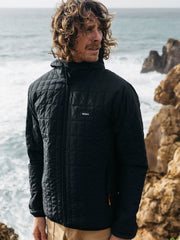We first met Richard ‘RJ’ Lilley of Project Seagrass when he spoke at our inaugural 'Ocean Mic Night' tour last year, at our Edinburgh event.
Project Seagrass: Seeds Of Hope
06.20.20
4 min read
Written by Richard Lilley
Images by Project Seagrass
Growing up in Birmingham I couldn’t really have spent my early days further from the ocean. Yet, when I cast my mind back to my formative years my memory is full of happy days spent down by the sea; whether that was visiting Dad's family down in Southampton, where my Grandad would spend endless days tinkering with his sailboat, or to my Mum's family in Edinburgh where we would take trips down the East Lothian coast to the beach at North Berwick and beyond. These trips to the sea were always taken in school holidays, and so I guess for me it was almost by default that I associated the sea with fun and freedom.
As I grew older, I lost touch with the sea. I attended an urban school where rugby became my passion, and so it was not until my later teenage years that I reconnected with the ocean. I remember the moment clearly. It was on a family trip in Ireland; we had been travelling and camping around the south-west coast. One evening I hired a board in Lahinch and I caught my first wave. Fifteen years old and the feelings came flooding back; I was hooked.
Fast forward 20 years and I feel very lucky to have spent a significant amount of my life in the ocean. I love the variety of its energies, the bustle of the coral reef, the boom of the breaking surf, or the calming tranquillity of a seagrass meadow full of life. I love how the ocean can go from flat calm to furious, and how its colours, and mood, can shift from crystal clear to slate grey. To me there is no place more peaceful, and where I can be more present, than in the ocean, but there are also few places more powerful. It constantly reminds me of how fleeting our time is on this blue marble.
Unfortunately, for much of my time, my experiences in the world’s oceans have been tinged with sadness, and on more than one occasion the feelings of raw, inconsolable grief. I feel deeply that I have spent too much time witnessing, and indeed documenting, the declines in biodiversity and ocean health. This is not what I want for my daughter.
It was in 2013, whilst studying for a PhD at Cardiff University, that I co-founded a small marine NGO with my supervisor and dive club colleague, which we based out of my living room – Project Seagrass was born.
But what is seagrass? For those of you who are unfamiliar with seagrass meadow habitat, you can rest assured that they look exactly like you'd imagine! Fields of green grass under the sea. Seagrass meadows produce oxygen, clean our coastal water, absorb greenhouse gas emissions, and help to keep our ocean healthy which stabilises the climate —both global and local. Not to mention, seagrass supports or provides habitat for 1000's of species of fish, invertebrates, birds, reptiles and mammals and supports the livelihoods of millions of people.
Our aim with Project Seagrass has always been to turn applied research into effective conservation action and education schemes, by collaborating with local communities and other stakeholders. As a dedicated team of seagrass scientists, we work to protect seagrass, and through seagrass, we support marine conservation more broadly.
“We are running the UK's first major seagrass restoration project. We are trying to plant two hectares of seagrass in west Wales, and if we can achieve it at that scale, then we can achieve it at a much bigger scale.”
Dr Richard Unsworth, Project Seagrass
In anticipation of the UN Decade On Ecosystem Restoration (2021-2030), our current UK work is focussing on seagrass restoration. Thanks to funding provided by Sky Ocean Rescue and WWF, we are currently working with the fantastic Swansea Marine team to plant 1 million seeds across a two-hectare site (two rugby pitches!). Last summer we reached out to SCUBA diving communities across the UK for volunteers to help us collect seeds, and the response was simply incredible. Then (after storing the seeds in the aquarium at Swansea University) this last winter we reached out to school groups to help us pack the hessian sacks with sand in preparation for deployment in February.
I write this Broadcast as the nation is in lockdown. However, despite the uncertainties of the present, it fills me with great optimism that those seeds are already safely in the water and that nature will be following its annual course. I can reassure myself that those seeds will now be germinating, small shoots climbing slowly towards the surface, whilst tiny roots will begin to push through the hessian weave, locking the new seedling firmly into the sediment.
It may be months before I can return to Dale, pull on my wetsuit, masks and fins, and swim out to check on the world’s youngest seagrass meadow, but I am optimistic that the wait will be worth it. The idea of diving through a rich green meadow teeming with life, where once there was none, is a personal goal worth holding on to hope for. Not least because it will be the first time in my life, I have returned to a dive site which is in be in better condition than when I left it!
At a time when we are all yearning for connection with our communities, and looking for signs of spring, of growth and renewal. I hope that the knowledge of these seeds, in a small corner of Wales, is able to bring to you the same comfort and optimism that it brings me.
















































































